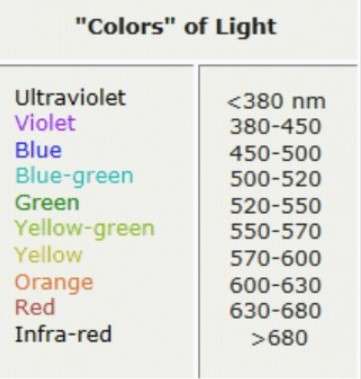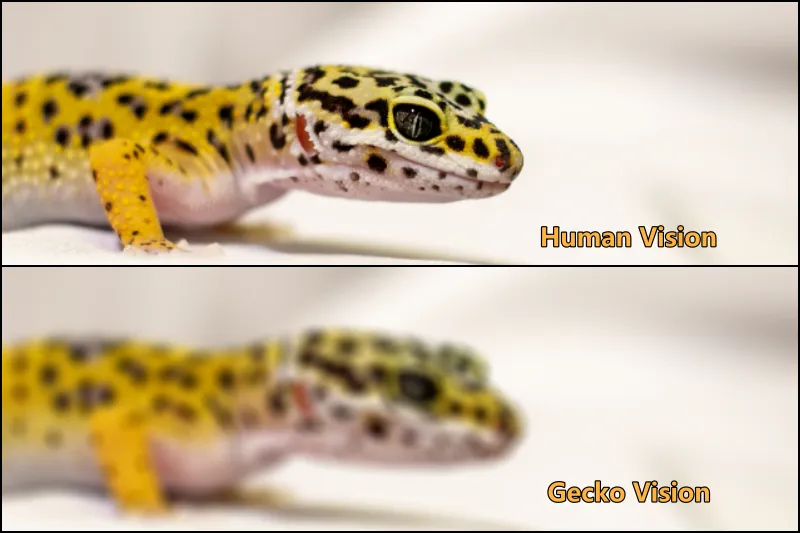Leopard Geckos are one of the most popular reptile pets that are native to the desert regions of India, Iran, Afghanistan, Pakistan, and Nepal. Many people love to pet them due to their skin contains beautiful xanthophores (yellow) and melanophores (black spots). But, have you ever wondered how Leopard Geckos see you or the world? How is its vision different than ours? If yes, then below is the answer.
Leopard Geckos have good eyesight and see the world in colors and details. They are nocturnal animals, which means their eyes have more rods than cones, allowing them to see much better in the dark. They can sense the environment 350 times better than humans at night.
In addition, Leopard Geckos are trichromatic by nature. They have three types of cones in their eyes that are sensitive to blue, green, and red colors. However, Geckos can perceive blue and green colors much better than red hues.
Here’s a brief answer to how Leopard Geckos see the world. Later on, we have explained this answer in detail. So, without any further delay. Let’s begin.
How do Leopard Geckos see the world?
Leopard Geckos have good eyesight compared to other gecko species. They are primarily dependent on their vision to search for food, sense predators, and select mates.
During the daytime, they cannot see much better compared to humans. However, at night, they visually glimpse their surroundings 350 times better than us.
The eyesight of diurnal geckos and nocturnal geckos are different. They evolve their vision depending on their habitat. And here we are discussing Leopard Geckos that are nocturnal by nature.
The eyes of Leopard Geckos are more concentrated on rods rather than cones. But the interesting fact is that they can also recognize colors even in low light conditions.

Remember- Rods in the eyes help to perceive the light’s brightness and are responsible for seeing better in the low light condition. On the other hand, cones assist in recognizing the color shades and clarity.
Leopard Gecko’s Vision
The research was done on geckos in which researchers fed them with colored tongs under dim moonlight. Over the period, it was noticed in the difference in geckos’ behavior towards the particular colored feeding tong.
After that, they changed the color of the feeding tongs, and the result concluded that geckos could easily distinguish blues from greens but not orange from reds. The study also proved that geckos absorb violet, blue, and green wavelengths more than other high-wavelength colors.
In addition, leopard geckos are primarily active during the time of dawn or dusk. This is because violet and blue mainly comprise the majority of the environment during this time, and they can see their surroundings more clearly.
Therefore, at that time, they carried out their major activities like searching for food and traveling.
Also, at night, leopard geckos can see much better with the help of light-sensitive rods in their eyes. Even in complete darkness, they can sense the slightest movements. Also, it has been proved that Leopard Geckos cannot perceive either ultraviolet or infrared light.
But they need some UV light from the environment to keep themselves warm at night. Therefore, many Leopard Geckos’ owners use UVB bulbs for them.
Not only this, Leopard Geckos have excellent peripheral vision, but they find it difficult to focus on far entities. They are near-sighted, and their eyesight is very sensitive to moving objects. And for non-moving entities, witness the outline of shapes.
Are Leopard Geckos color-blind?
No, Leopard Geckos are not colorblind. They can see fewer colors compared to humans. Leopard Geckos are trichromatic. It represents that they have three types of cones in their eyes that perceive small, medium, and large wavelength colors.

However, it is glimpsed that Leopard Geckos are less sensitive toward red hues. They have a visual system with absorption maxima from 380 nm to 570 nm wavelength. As the wavelength increases, their optical absorption reduces.
In addition, Leopard Geckos can see colors even in dim light. The higher rod ratio is spectacularly sensitive in the dark, granting them the ability to recognize colors in night vision. Also, during the day, geckos close their vertical pupils to tiny slips avoiding direct sunlight rays.
What colors can Leopard Geckos see?

At best, Leopard Geckos can primarily see violet, blue, and green shades from 380 nm to 570 nm wavelength. Also, their eyes are efficient in perceiving violet, blue, and green color shades even in the dark. This is due to the presence of optics and the large cones that provide color vision at low light intensities.
Can Leopard Geckos see in the Dark?
Yes, Leopard Geckos can see 350 times better than humans in the dark. They are nocturnal reptiles; therefore, their eyes are more concentrated on the rods than cones.
They evolve their eyes to search for prey, travel, and carry out daily activities at night. Also, nocturnal geckos can sense moving objects even in complete darkness.
In a nutshell, they have better night vision than any other reptiles, which assists them in distinguishing the outlines of the stationary objects, as shown in the image above. To know more, visit the article below.
Must Read- Can Lizards See in the Dark?
Gecko vision vs. Human vision
| Gecko vision | Human vision |
| Geckos are trichromatic. | Humans are also trichromatic. |
| They perceive violet, blue, and green colors at best. | We perceive blue, green, and red colors at best. |
| They have better night vision. | Humans are not able to see in the dark. |
| Geckos cannot recognize far objects with clarity. | We can visually discern far objects with clarity. |
Here, we conclude our article on “How do Leopard Geckos see the world” and explain the difference between Gecko vision and Human vision. We hope you like it. We will be back with another post. Till then, stay tuned with us and read the articles given below.
Frequently Asked Questions:
Q1. How good can leopard geckos see?
Ans. Leopard Geckos can see the world much better than other lizards (not as well as chameleons). However, they have a blurry vision as you can see in the image mentioned above.
Q2. Do leopard geckos recognize humans?
Ans. Yes, they can! But by their scent. While Leopard geckos have good eyesight they rely mostly on their keep sense of smell which helps them to identify their owners.
Q3. What is the vision of a gecko?
Ans. Geckos have a blurry vision (still better than most lizards). They are near-sighted and their eyes are sensitive to moving objects which helps them to track their prey.
Q4. How does gecko vision compare to human vision?
Ans. Geckos are near-sighted whereas humans can see far objects too. The only advantage Geckos have is better night vision compared to us. Their eyes are more concentrated on the rods than cones.
Q5. Which reptile has the best eyesight?
Ans. Among all the reptiles, lizards have the best eyesight to see the world and among lizards, Chameleon are the most highly visually-oriented species.
Q6. Which lizard has the best eyesight?
Ans. Chameleons have the best eyesight compared to all lizards. They can see the world as clearly as humans. Also, their 360-degree vision helps them to track prey easily.
References-
Gecko Vision by Science Direct
Also Read

Meet Monty, the visionary founder of How It See, being an engineering student, he’s fueled by an insatiable curiosity about the world around him. He is captivated by an eclectic correlation between animal groups, science, and nature, and this fascination drives his quest for understanding.
After completing his degree, he’s set on a mission to delve deep into the realm of nature, accumulating knowledge to share with you through his writing. In the meantime, he loves to watch anime and read anime.

